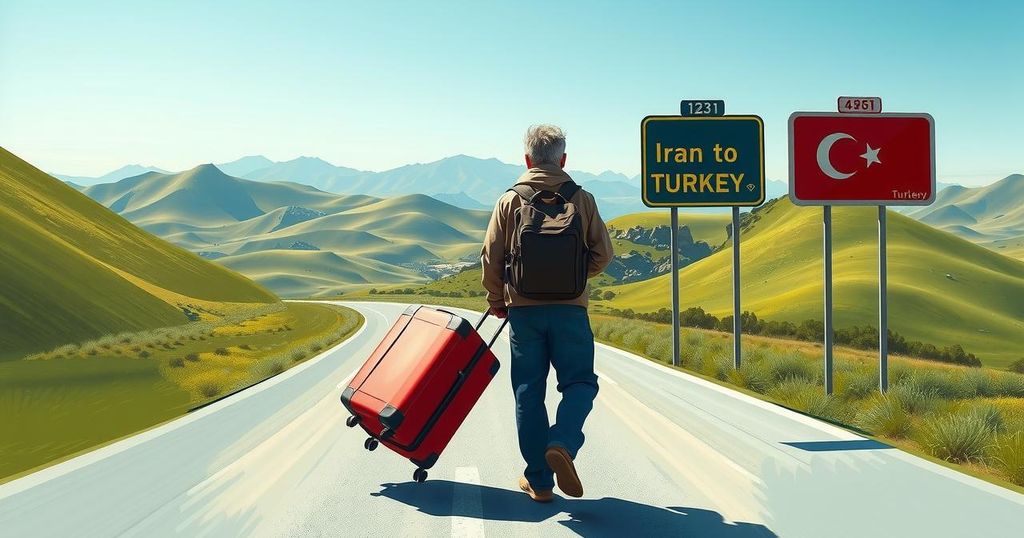Iranian Woman’s Grueling Journey from Tehran to Toronto Amid Israel-Iran Conflict
As the Israel-Iran war continues, Homa, an Iranian émigré in Toronto, shares her ordeal of fleeing Iran through Turkey. After the Iranian airspace closure, she undertook a grueling journey across borders, reflecting broader concerns about safety and stability amid ongoing violence. While some are leaving, others maintain confidence in their homeland, indicating a complex reaction to the unfolding crisis.
Homa, a 40-year-old Iranian, found herself in a dire situation as she scrambled to leave Tehran amidst the escalating Israel-Iran war. After Iran closed its airspace due to a major bombing campaign, she was left with no options for air travel back to Toronto, where she works as a business analyst. Dragging along two suitcases and wearing a rucksack, exhaustion marked her appearance after traversing the intense conflict zone to Turkey.
She embarked on a long, 850-kilometer journey by bus to reach the northwestern border with Turkey, the Kapikoy crossing in the Van province. Homa left Tehran late Tuesday night, navigating through a city fraught with violence and chaos. “I am worried about them,” she said, reflecting on her family’s escape from the turmoil. Many others were also attempting to flee the escalating crisis, including her relatives, caught in heavy traffic.
The ongoing conflict has resulted in the deaths of at least 224 people in Iran due to Israeli attacks, with Israel reporting 24 casualties from Tehran’s retaliation. Despite the dangers, Homa still faces a lengthy trip back to her home in Toronto, having to first reach Erzurum, Istanbul, then finally Dubai before her flight home.
In describing her harrowing experience, Homa recounted, “I couldn’t sleep for five nights in a row” due to the relentless bombardment which forced her to seek refuge in northern Tehran. Communication was another struggle, she explained, saying, “The internet is awful,” and that platforms like Telegram and WhatsApp have been heavily filtered.
At the Kapikoy border crossing, the flow of people appeared steady, with only a few hundred Iranians crossing as of Wednesday, according to AFP correspondents on duty. A Turkish customs official noted, “There’s nothing unusual compared to last year. Despite the war, the arrivals are quite stable.”
However, bus drivers in the area reported an uptick in passengers — unprecedented growth in transportation demand given the circumstances. A driver named Ismail Metin remarked that they were operating far more buses than usual, with a clear shift in the number of people wanting to travel to Istanbul, approximately 1,500 kilometers away.
Some travelers, like 37-year-old Ramin Rad, expressed optimism about returning home. Found in Van on business, he was keen to get back to Urmia. “My family is safe,” Rad insisted, demonstrating a resigned confidence in the Iranian regime’s resilience against foreign threats. Comparatively, Mirzanezhad Valehzagherd indicated a stable atmosphere in Tehran, refuting claims of mass exodus despite the ongoing violence. He noted, “People are not fleeing Tehran.”
The conflicting narratives emerged as more travelers shared their stories at the border — one woman from northern Cyprus stated, “It’s safe over there. There’s no problem.” This duality in experiences raises unanswered questions about how civilians interpret the chaotic situation in their homeland as fears of war loom large.
In summary, Homa’s flight from Tehran encapsulates the harrowing experiences that many Iranians endure amid the ongoing Israel-Iran conflict. Despite escalated violence, there appears to be varying perceptions regarding safety and the stability of life in Tehran. While many like Homa are seeking to leave, others express determination to stay, indicating complexities in the situation that go beyond mere flight from danger. The dynamics at the Kapikoy border reflect both a steady trickle of departures and returnees, highlighting a multifaceted human struggle at the crossroads of conflict.
Original Source: www.yahoo.com




Post Comment